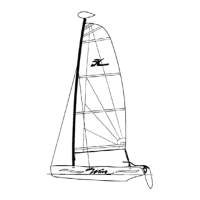28
hobie.com
Sailing Basics
Turning
To tack or turn the boat into and across the wind to the opposite
direction (also known as “coming about”), follow the points of sail
guide illustration and take the boat to the close hauled point of sail.
This is when you are nearly 35 degrees from sailing straight into the
wind. With the boat moving forward and not staling, push the til-
ler away from you slowly. When the boat is pointing straight into the
wind the boat will become level. Ease the mainsheet trim out just a
little. At this time move your body to the other side of the boat, switch
hands with tiller and mainsheet and begin to bring the rudder back
to straight. The crew should move across the trampoline at the same
time. The crew is responsible to ease the jib sheet just after the main
sail is released and sheet the jib onto the new course before the
mainsheet is trimmed. This action by the crew will prevent the boat
stalling head to wind. As the boat comes across the wind and falls off
onto the opposite, close hauled point of sail, bring the tiller all the way
back to proper sail trim. If you stall pointing into the wind and you
cannot steer the boat, refer back to the sail power description
concerning getting stuck in irons.
When sailing downwind, the turn from one point of sail across to the
other is called a jibe. The jibe is completed by turning away from the
wind (falling off) to the opposite point of sail rather than into the wind
as when tacking. Care must be taken when attempting a jibe as the
boat will be at full power and you cannot easily de-power it without
turning back into the wind. Also, be aware that the boat will be less
stable in this maneuver as the sail will now have to swing clear across
from fully out one side of the boat to fully out the other.
To start a jibe, turn the boat away from the wind and let the sail out
slowly. Keep the turn going at a steady rate and being pulling the sail
back in as the boat nears the straight downwind direction. This will
help prevent the sail from slamming all the way across when the sail
fills from the opposite side. Duck below the sail to avoid getting hit
as the wind fills the sail from the opposite side and swings across the
boat. Attempt to control the speed of the sail while it crosses the deck
by maintaining some tension on the mainsheet. Then ease the main-
sheet out quickly as the boat turns past the downwind direction onto
the new point of sail. Trim the sail according to the desired point of
sail.

